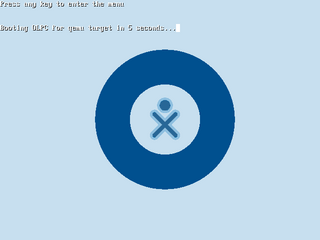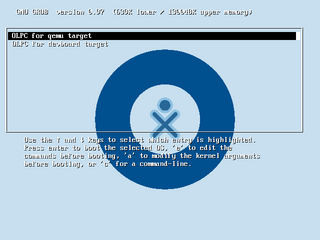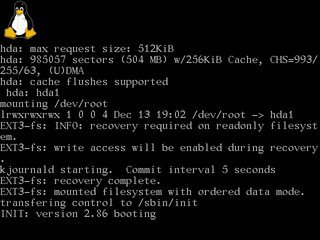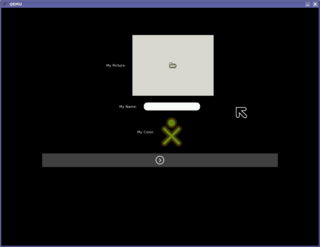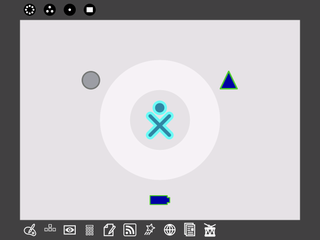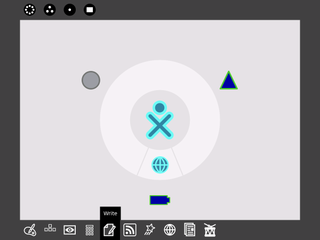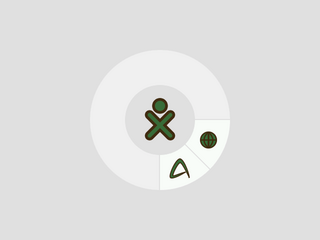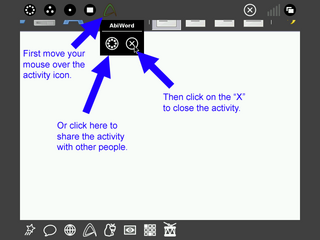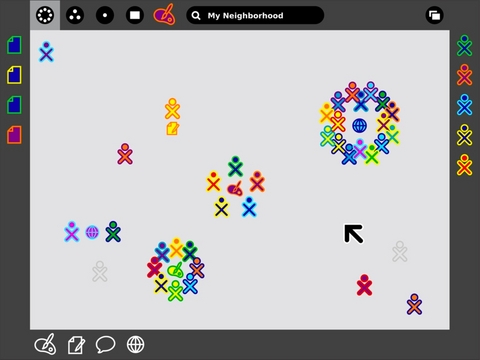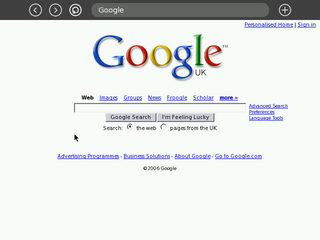Sugar Instructions
Contents
Different Builds of Sugar
The Sugar software is evolving rapidly, so there are different instructions, depending which version you have. The OLPC software comes in "builds", which are loaded into the laptop's firmware (or booted from a CD image, USB key, or SD card). This page documents the Sugar version in the current stable build (Build 385). You can find all versions of this documentation in [Category:Sugar].
Installing
If you have an OLPC laptop, Sugar is already installed. Otherwise you can either use an emulated laptop, which will have Sugar built in, or you can install Python on your desktop PC and run the Sugar application directly on your PC. If you are running Sugar from Python then you can skip most of the stuff in the next section, up to choosing your user name.
First Booting on an Emulated OLPC Laptop
When you first open an OLPC image using an emulator, you will see this screen. Just press enter, or wait a few seconds.
This screen will appear. Again, just press enter if you are using an emulator.
Then several screens of text will fly past as Linux begins to load. Just wait until you see the Sugar desktop shown later.
Then it will go to a login prompt. You don't have to type anything. Just wait and it will start the GUI. If you don't want to wait for the GUI to load, you can log in with username "root" and no password.
If you wait, the GUI will start. If the GUI fails to start, you may have forgotten to choose emulated when you booted, or you may have encountered the "GUI won't start" bug. The "GUI won't start" bug is fixed by reinstalling the hard disk image. In QEMU, delete the .img file (it has become corrupted), and extract the original .img file from the bz2 file, or download the image file again. Upgrading to a later version isn't necessary.
Choosing a name and colors
The first time Sugar starts it will show a screen where you must type in an username and choose icon colors. (In some pre-303 builds, you also need to select a picture.) You must type in a username; currently the name is used infrequently, but it will appear in a hover over your iconic representation in the mesh view—on your laptop and on other XOs on the same mesh network. The icon colors have been randomly chosen; you can change them by clicking in the XO icon: keep clicking until you get an acceptable color combination. (This will be made interactive in later builds.) Press Enter or click on the ">" button to continue.
Getting Started with the Sugar Desktop
Home Mode
The Sugar desktop starts up in Home mode. This shows an XO icon, representing you and your laptop, in the centre of the screen.
Later on we will see many people, but at the moment we can only see you. Each person is a different colour.
The Frame Is How You Control Sugar
The "Frame", a black border around the edge of the screen, is where many of Sugar's controls are. The frame can appear and disappear, making more room on the screen for activities. It is usually visible on the main screen with the ring, since the edges of that screen aren't used for anything else. If it is not visible, move your mouse pointer to a corner of the screen. The Frame will appear, and will stay visible as long as the mouse pointer doesn't leave the frame area for more than about half a second at a time.
You can also make the Frame appear or disapper by pressing the upper rightmost key on the OLPC keyboard (it has a rectangle on it, like a picture frame).
Opening an Activity
Sugar uses "activities" rather than "applications".
For example a web browser is a type of activity in Sugar. The ring around you shows which activities are running. At the moment there are no activities running, so the ring is empty.
So let's open an activity. To open an activity, look at the bottom of the frame, where there are some icons. These are the activities that you can open.
For example, Write (a word processsor based on AbiWord) is shaped like a sheet of paper with a pencil on it. To open an activity, click on its icon. A copy of the icon will move up into the ring, and pulse while the application starts up.
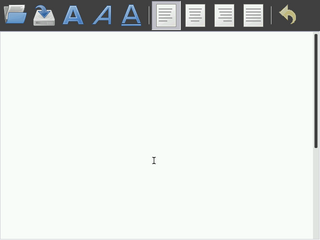
After a few seconds a new screen will appear. (The screen image to the right is from an old version of Write; it's been improved since we took that screen shot).
You can open several activities at the same time, by going to the bottom of the frame, and clicking on another icon. You can only see or interact with one of them at once.
Switching View Modes
To see which activities are open, go to the frame, and in the top, near the left corner, you will see four "Zoom Icons".
There are three different levels of "zoom", so you can see not just yourself and your activities, but also your friends, or everyone on the local network.
- Neighborhood Shows everyone in the "Neighborhood", and what activities they are sharing.
- Friends Shows only you and your friends, and their activities.
- Home Shows only you and your activities
- Bulletin Board Toggles an extra transparent layer on top of the view, where you can add comments and stick items, like an old-fashioned bulletin board, that you want to share with everyone in that view.
Click on the "Home" view (The circle with a single dot inside) or press F3 on the keyboard.
If you have a real OLPC laptop, you can also change the zoom mode by pressing the appropriate button on the top of your keyboard, shown here.
Now you will see your XO icon in the center, and the Write icon in the surrounding circle.
Switching Between Activities
If you have more than one activity running, you can switch to it by clicking on the appropriate icon in the ring.
The size of the ring segment that an activity occupies is intended to represent its overall memory usage, but that feature does not work yet. When the ring fills up, no additional activities may be launched until some resources are freed up. In today's XO laptops, only a few activities can be started at the same time, and when memory is exhausted, one of them will die suddenly without any warning.
There are currently ten activities on the frame. (The picture to the right is out of date.)
| | | | | ||||||
|---|---|---|---|---|---|---|---|---|---|
| Squeak Etoys dynamic media authoring system | Web Browser | Camera, a basic camera test | TamTam Play music and record compositions | Paint Image painting | BlockParty Game: blocks drop out of the sky, you arrange them | Calc Calculator | [News Reader] RSS Newsreader | Write Word processor | Read Book reader |
Closing or Sharing Activities
To close an activity that's already open, select it from the ring (for example, Write) if it is not already visible on the screen.
Then go to the top of the frame. You will see the activity's icon (e.g. the Write icon) at the top of the frame, near the center.
Move your mouse on the icon but don't click. Hover there for a moment. A little menu will appear below it.
Click on the "X-in-a-circle" icon to close the activity.
In the future you will be able to share an activity with other people, by clicking on a "Circle of a few dots" icon in the same menu. Currently that doesn't work. If it did, you could find out more about sharing activities with others, by reading about Neighborhood View Mode.
Neighborhood View Mode
Neighborhood mode is intended to show you other people connected on the network. Currently it doesn't work at all. Later, it will also show you which activities they are running, and which activities are being shared. Each person is represented by a different color combination.
The activities are colour coded with the colours of whoever started the activity. In this case the painting activity was started by the orange and purple girl, who you can see surrounding the orange and purple activity in the Neighborhood view in the middle of that screen.
The left frame is the clipboard. You can copy multiple items to the clipboard.
The right frame is your buddy list. It shows your friends that are online.
The bottom frame is like the windows start menu that you use for launching applications. The icons represent different activities that you can start. In the above screen shot, the activities are from left-to-right: painting, word processor, chat, and web browser. You will also have other activities on your laptop. A shooting star icon will represent Squeak e-toys, which is a fun visual programming and drawing application.
When you receive an invitation from your friend to join an activity, it will appear in the bottom frame in colour. A pop-up menu lets you accept or reject the invitation. Notifications may also appear in the bottom frame.
The top of the frame has the icons for "neighborhood", "friends", "home", and "bulletin board", just like on the keyboard. It also has something like the Windows "task bar" with the icons for the currently running activities.
In recent builds (> 300), internet access points (infrastructure mode) appear as triangles on the mesh view. You select an access point by clicking on it in this view. Your status appears on the homepage, also in the form of a triangle. In future builds (>330), a mesh status will also be shown in both views. We are considering adding functionality to the friends view to allow one to collect "favorite" access points.
Shortcut Keys
You can use the following shortcut keys in Sugar:
- F1 : Zoom to Neighborhood view
- F2 : Zoom to Friends view
- F3 : Zoom to Home view
- F4 : Zoom to Activity view
The following key combinations use modifier keys. For example "Alt+f" means "Hold down the 'Alt' key, then press the 'f' key, then release both keys."
- Alt+f : Toggle the frame
- Alt+= or Alt+0 : Open the Developer Console (includes terminal (linux prompt) as user "olpc", you won't be able to log in as "root"; and the sugar-log-viewer window)
- Alt+r : Rotate the screen
- Alt+q : Quit Sugar when running within a development environment (i.e. not when running an emulator image or on an OLPC laptop)
The following Linux key combinations can be used when running Sugar in an emulator image or on an OLPC laptop:
- Ctrl+Alt+F1 (hold down) : Leave the Sugar screen, and go to the Linux prompt, so you can log in as "root" with no password.
- Ctrl+Alt+F7 (hold down) : Return to the Sugar screen
- Ctrl+Alt+Backspace : Terminate Sugar immediately without closing down properly. It will restart automatically in the background (use Ctrl+Alt+F7 to see it restarted).
Note: The shortcut keys seem to change with some regularity--apparently the most accurate information is found in the Sugar README or the source.
Terminal (linux prompt)
You can access the linux prompt in two ways... Either hold down Ctrl+Alt+F1 to leave the Sugar screen and return to the login prompt, or open the Developer Console activity within Sugar and select the terminal tab.
If you use Ctrl+Alt+F1 to leave Sugar, you can return to Sugar with Ctrl+Alt+F7.
If you use the terminal in the Developer Console you won't be logged in as "root" but as "olpc". You need to be logged in as "root" to edit some of the setup files, such as "/boot/grub/grub.conf". You can gain root access by typing "su -". The prompt suffix will change to # which denotes that you are root. You will not be able to start any graphical programs as root using this method.
For example, if you want to edit "/boot/grub/grub.conf" with AbiWord in Sugar, hold down Ctrl+Alt+F1 to leave Sugar, and type "root" for the log in. Type "chmod a+rw /boot/grub/grub.conf". Then return to Sugar by holding down Ctrl+Alt+F7. Now you can open and save that file in AbiWord.
Some basic linux commands you can use at the prompt are:
- ls -al (get a list of the files)
- cd dirname (change to directory dirname)
- cat filename (show the contents of filename)
Web browser
The Sugar web-browser is started by the clicking the wireframe globe icon in the bottom frame. ![]()
The browser is based on Mozilla Firefox.
It has a simple interface. By default it has one toolbar across the top, with back, forward, and reload buttons, followed by a box with the page title or URL, and a "+" button which adds an extra browser tab. If you click the "+" button then it adds a new tab, and a new toolbar appears on the left side of the screen which displays all the tabs. I couldn't work out how to close tabs.
When you click on the title box, it will change to showing the URL, and you can type in a new address and press Enter to make it go there. The title box also shows the loading progress as a bar in the background.
Don't confuse the tool bars with the similar looking frame. You can still move the cursor to the corner of the screen to pop in the frame over the top. You can then click on the coloured wire-frame globe icon in the top frame and choose close from the drop down menu.
NOTE: Currently, when a link opens in a new window, you will be stuck in that window until you close it from the top frame, at which point you will see the previous window until you close all the browser windows.
If you cannot get an internet connection in the sugar browser, look here.
Shutting Down the System
To shut down the whole system, simply push the power button on the bezel; it's below the lower right corner of the screen. This currently only works when the screen is showing graphics (as it is now). The system should leap to action immediately, and turn itself off within half a minute or so. If this doesn't happen, you can also force a power-off by pressing and holding the power button for many seconds.
Detailed description of the Sugar Interface
For more info on the Sugar interface, have a look at the Human User Interface Guidelines.
